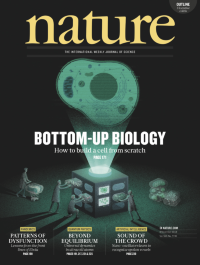Volume 563
-
No. 7733 29 November 2018
Clear connectionsIn many physical networks, such as neurons in the brain or 3D integrated circuits, the nodes and links are themselves physical objects and so cannot intersect or overlap with each other. But the mathematical frameworks used to describe such networks pay scant attention to the actual space occupied by these components and usually fail to account for the ‘no-crossing’ criterion. This effect becomes increasingly important as the packing density of the network increases. In this week’s issue, Nima Dehmamy and his colleagues reveal a theoretical framework that accounts for such physical constraints. This allows the researchers to explore how non-crossing conditions affect a network’s geometry and change the 3D architecture as the packing density alters. The cover image shows two networks laid out in 3D based on the team’s mathematical framework and printed with a 3D printer. On the left is a scale-free network generated by the Barabási–Albert model, while on the right a random network generated by the Erdős–Rényi model.
Nature Outlook
-
No. 7732 22 November 2018
A first for flightFor more than 100 years, aeroplanes have taken flight thanks to engine-based propellers and turbines, mostly powered by fossil fuels. In this week’s issue, Steven Barrett and his colleagues reveal an alternative: a plane powered by a near-silent engine that has no moving parts. Solid-state propulsion systems use electric fields to ionize the molecules in the air, which then collide with neutral molecules, resulting in an ionic wind that generates thrust. It had been thought that thrust-to-power limitations would prevent such systems from propelling planes but the researchers demonstrate this is not so with the sustained flight of a solid-state aeroplane. Weighing 2.45 kilograms, the plane has a 5-metre wingspan and carries a battery stack and power converter that produces around 500 watts. In the test flights, the plane achieved a thrust-to-power ratio comparable to that of a jet engine, although the overall efficiency was lower. This proof of concept opens up possibilities for electroaerodynamic propulsion, which could lead to quieter, low-emissions aeroplanes.
Nature Outlook
-
No. 7731 15 November 2018
Secrets of pregnancyThe cellular changes that occur in the early stages of pregnancy lay the foundations for reproductive success. In this week’s issue, Sarah Teichmann and her colleagues present a single-cell atlas of the interface that forms between mother and the developing fetus. The researchers performed RNA sequencing on some 70,000 cells from first-trimester placentas with matched cells from the mother’s blood and uterus. They uncovered remarkable complexity in the cell types and the cell–cell communication networks that form to support the growing fetus. The network shows that the mother’s immune system adapts to support the placenta as it implants and develops in the wall of the uterus. The atlas should help identify the causes of problems in pregnancy such as pre-eclampsia and stillbirth.
Focal Point
-
No. 7730 8 November 2018
Bottom-up biologyIn trying to unpick the mysteries of how cells work, the standard approach has been to work from the top down, dissecting the way various cellular components interact in their natural environment. But technical advances now allow researchers to use engineering principles to reconstruct biological processes from the bottom up. This special issue explores the potential and possible limits of bottom-up cell biology. From developing membranes and metabolic pathways to designing cell-like systems for medical applications, and creating cell layers that stretch and deform, researchers are piecing together the complex world of the cell.
Nature Outline
-
No. 7729 1 November 2018
Action potentialTwo papers in this week’s issue examine the remarkable diversity found among neurons in the brain. Bosiljka Tasic and her colleagues used deep, single-cell RNA-sequencing on 23,822 cells from across the visual and motor cortices in mice to reveal 133 cell types based on gene-expression profiles. They found that nearly all types of inhibitory neurons were shared across the two regions, whereas most types of excitatory neurons were area-specific. In related work, Karel Svoboda, Michael Economo and their colleagues demonstrate that several of these cell types, those corresponding to pyramidal tract neurons (pictured) — a particular subpopulation of excitatory neurons — differ in other ways beyond gene expression. They showed that different pyramidal tract cell types each connect to a unique set of brain regions and communicate specific signals involved in the preparation and initiation of motion, respectively. Together, these studies demonstrate the power of such data sets to reveal the intricate details of neuronal function.
Nature Index





